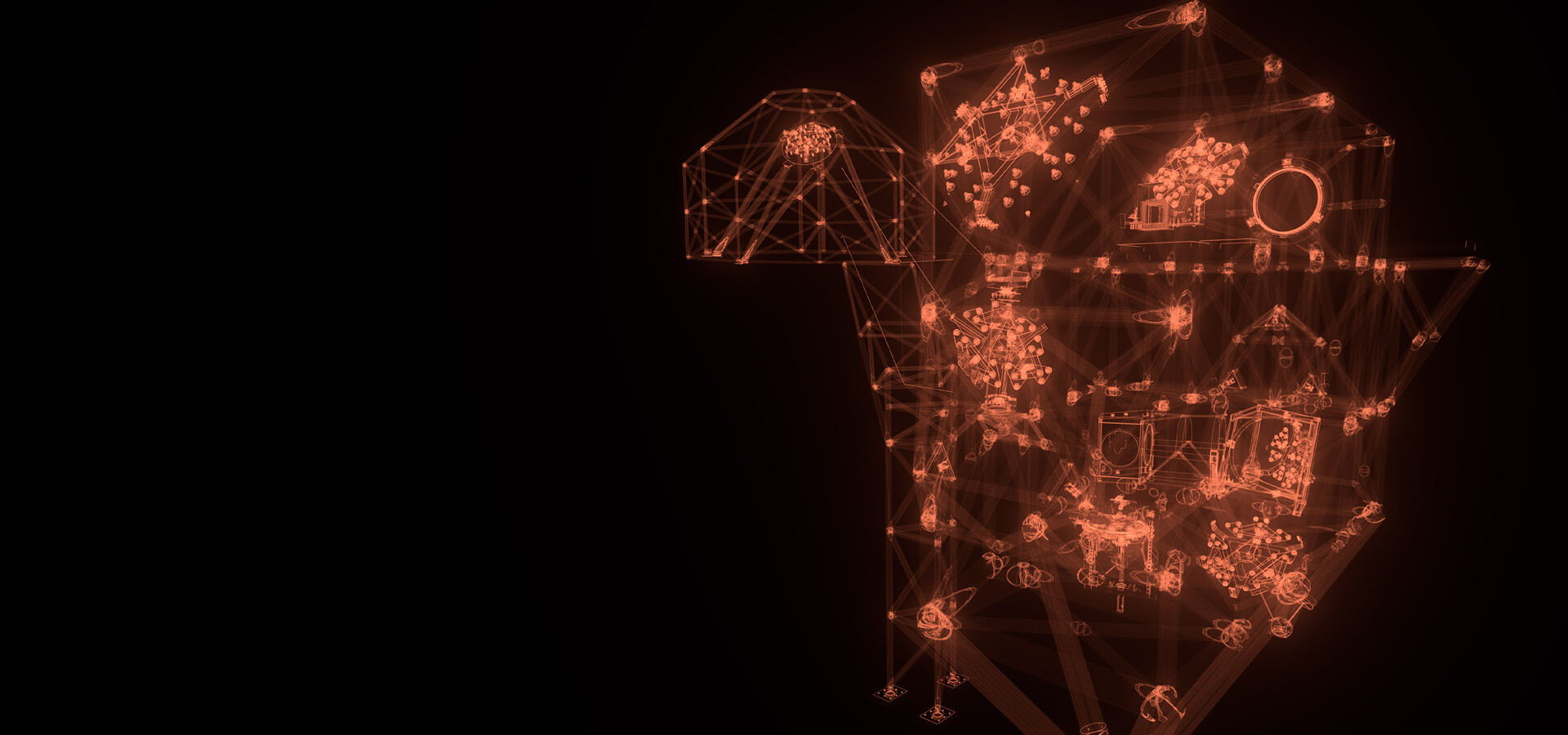
European
Southern
Observatory


Como instrumento del ELT de primera generación, MORFEO (Multiconjugate adaptive Optics Relay For ELT Observations) ayudará a compensar la distorsión de la luz ocasionada por las turbulencias de la atmósfera terrestre que hacen que las imágenes astronómicas sean borrosas. MORFEO no realizará observaciones por sí mismo, sino que permitirá que otros instrumentos, como MICADO en primera instancia, tomen imágenes excepcionales.
Como instrumento del ELT de primera generación, MORFEO (Multiconjugate adaptive Optics Relay For ELT Observations) ayudará a compensar la distorsión de la luz ocasionada por las turbulencias de la atmósfera terrestre que hacen que las imágenes astronómicas sean borrosas. MORFEO no realizará observaciones por sí mismo, sino que permitirá que otros instrumentos, como MICADO en primera instancia, tomen imágenes excepcionales.
Como instrumento del ELT de primera generación, MORFEO (Multiconjugate adaptive Optics Relay For ELT Observations) ayudará a compensar la distorsión de la luz ocasionada por las turbulencias de la atmósfera terrestre que hacen que las imágenes astronómicas sean borrosas. MORFEO no realizará observaciones por sí mismo, sino que permitirá que otros instrumentos, como MICADO en primera instancia, tomen imágenes excepcionales.
Los telescopios terrestres modernos no pueden alcanzar todo su potencial sin la óptica adaptativa, que son estos sofisticados sistemas que corrigen los efectos de desenfoque de la turbulenta atmósfera terrestre y nos permiten obtener imágenes nítidas de objetos astronómicos cercanos y lejanos. MORFEO es uno de los principales sistemas de óptica adaptativa del ELT y trabajará con la cámara de infrarrojo cercano MICADO durante los primeros años de funcionamiento del telescopio; además, está diseñado para alimentar también de luz a un segundo instrumento en el futuro. Para que los científicos puedan realizar mediciones muy precisas de las posiciones, el brillo y los movimientos de las estrellas, MICADO necesita imágenes estables y nítidas en un amplio campo de visión, y la óptica adaptativa proporcionada por MORFEO le ayudará a conseguirlo.
MORFEO utilizará espejos deformables y otros sistemas de última generación para corregir las distintas capas de turbulencia que existen en lo alto por encima del ELT. En particular, su trabajo se basará en seis estrellas guía láser (artificiales), proyectadas desde alrededor de la circunferencia del espejo primario del ELT y dispuestas en un círculo en el cielo, que se utilizarán como referencia para medir la distorsión causada por la atmósfera terrestre. Estos láseres ayudarán a MORFEO a obtener un mapa tridimensional de las turbulencias atmosféricas.
MORFEO es un sistema de óptica adaptativa multiconjugada: no realizará observaciones científicas por sí mismo, sino que permitirá que otros instrumentos realicen observaciones con una excelente calidad de imagen.
En combinación con MICADO, y aprovechando al máximo el mayor poder de captación de luz del ELT, MORFEO ayudará a los astrónomos a observar galaxias distantes con corrimientos al rojo de aproximadamente 2-3 con un nivel de detalle sin precedentes. Esta es una época importante en la historia del Universo, ya que estamos observando la luz de las galaxias en el momento en que los astrónomos creen que se formó la mayoría de ellas. Además, al tomar imágenes espacialmente resueltas con el ELT, se pueden medir los sitios individuales de formación estelar en las galaxias y determinar sus características físicas.
MORFEO también permitirá a MICADO observar más de cerca que nunca el enorme agujero negro situado en el centro de la Vía Láctea. Considerando que el agujero negro afecta las órbitas de las estrellas cercanas, los astrónomos han mapeado, con instrumentos anteriores, los movimientos de estas estrellas hasta una distancia de 25 días luz del agujero negro, pero el dúo MORFEO/MICADO llegará a una distancia de solo cinco días luz.
MORFEO es un sistema de óptica adaptativa multiconjugada: no realizará observaciones científicas por sí mismo, sino que permitirá que otros instrumentos realicen observaciones con una excelente calidad de imagen excelente.
MORFEO utilizará nueve estrellas guía (tres estrellas reales y seis estrellas láser artificiales), sensores de frente de onda de última generación y hasta tres espejos deformables para medir y corregir las turbulencias a tres alturas diferentes en la atmósfera.
Para medir la turbulencia atmosférica, MORFEO observará tres estrellas guía naturales alrededor del campo de visión científico de la cámara (MICADO), pero también utilizará las estrellas guía láser del ELT para alcanzar la exigente calidad de imagen que requieren los ambiciosos objetivos científicos de MICADO. La distorsión de la luz ocasionada por las turbulencias atmosféricas se medirá mediante sensores de frente de onda que usan detectores de nueva generación capaces de leer imágenes cientos de veces por segundo con bajo ruido.
MORFEO utiliza seis grandes espejos para conducir la luz desde el plano focal del telescopio hasta el plano focal de MICADO. Inclinando uno de esos espejos, es posible dirigir el haz de luz hacia MICADO o hacia el segundo instrumento cliente. Los sensores de frente de onda de las estrellas guía naturales están conectados físicamente a MICADO para maximizar el rendimiento científico. Un divisor de haz dicroico en la trayectoria óptica separa la luz (láser) de longitud de onda corta en el módulo de estrella guía láser desde la luz infrarroja hacia los instrumentos científicos y las cámaras del sensor de frente de onda de la estrella guía natural.
Multi-conjugate AO system
Six laser guide stars and three natural guide stars
Up to two deformable mirrors
in addition to ELT M4 to correct atmospheric turbulence
Two ports for instruments
MICADO and a future spectrograph
Single-conjugate AO
as joint development between MORFEO and MICADO
Performance requirements
50% Strehl ratio at 2.2 μm in the best conditions
30% Strehl ratio at 2.2 μm in the median conditions
Sky coverage
50% at the South Galactic Pole
Herramienta para predecir el tiempo de exposición necesario para estudiar un objeto con el instrumento, para unas condiciones ambientales determinadas.
Descripción de las motivaciones científicas del instrumento, presentadas inicialmente por el Consorcio del Instrumento.
El proyecto MORFEO es administrado, junto con ESO, por un consorcio internacional compuesto por tres institutos de investigación: el Instituto de Ciencias Planetarias y Astrofísica de Grenoble (IPAG) de Francia, el Instituto Nacional de Astrofísica (INAF) de Italia y la Universidad de Galway de Irlanda.
Investigador Principal
Paolo Ciliegi (INAF Osservatorio Astronomico di Bologna, Italy)
Científico de Proyecto
Francesca Annibali (INAF Osservatorio di Bologna, Italy)
Jefe de Proyecto
Andrea Di Rocco (INAF Osservatorio di Bologna, Italy)
Ingeniero de Proyectos ESO
Científico de Proyecto ESO
Jefe de Proyecto ESO
We use cookies that are essential for accessing our websites and using our services. We also use cookies to analyse, measure and improve our websites’ performance, to enable content sharing via social media and to display media content hosted on third-party platforms.
The European Organisation for Astronomical Research in the Southern Hemisphere (ESO) is the pre-eminent intergovernmental science and technology organisation in astronomy. It carries out an ambitious programme focused on the design, construction and operation of powerful ground-based observing facilities for astronomy.
This Cookies Policy is intended to provide clarity by outlining the cookies used on the ESO public websites, their functions, the options you have for controlling them, and the ways you can contact us for additional details.
Cookies are small pieces of data stored on your device by websites you visit. They serve various purposes, such as remembering login credentials and preferences and enhance your browsing experience.
Essential cookies (always active): These cookies are strictly necessary for the proper functioning of our website. Without these cookies, the website cannot operate correctly, and certain services, such as logging in or accessing secure areas, may not be available; because they are essential for the website’s operation, they cannot be disabled.
Functional Cookies: These cookies enhance your browsing experience by enabling additional features and personalization, such as remembering your preferences and settings. While not strictly necessary for the website to function, they improve usability and convenience; these cookies are only placed if you provide your consent.
Analytics cookies: These cookies collect information about how visitors interact with our website, such as which pages are visited most often and how users navigate the site. This data helps us improve website performance, optimize content, and enhance the user experience; these cookies are only placed if you provide your consent. We use the following analytics cookies.
Matomo Cookies:
This website uses Matomo (formerly Piwik), an open source software which enables the statistical analysis of website visits. Matomo uses cookies (text files) which are saved on your computer and which allow us to analyze how you use our website. The website user information generated by the cookies will only be saved on the servers of our IT Department. We use this information to analyze www.eso.org visits and to prepare reports on website activities. These data will not be disclosed to third parties.
On behalf of ESO, Matomo will use this information for the purpose of evaluating your use of the website, compiling reports on website activity and providing other services relating to website activity and internet usage.
Matomo cookies settings:
Additional Third-party cookies on ESO websites: some of our pages display content from external providers, e.g. YouTube.
Such third-party services are outside of ESO control and may, at any time, change their terms of service, use of cookies, etc.
YouTube: Some videos on the ESO website are embedded from ESO’s official YouTube channel. We have enabled YouTube’s privacy-enhanced mode, meaning that no cookies are set unless the user actively clicks on the video to play it. Additionally, in this mode, YouTube does not store any personally identifiable cookie data for embedded video playbacks. For more details, please refer to YouTube’s embedding videos information page.
Cookies can also be classified based on the following elements.
Regarding the domain, there are:
As for their duration, cookies can be:
Cookie settings: You can modify your cookie choices for the ESO webpages at any time by clicking on the link Cookie settings at the bottom of any page.
In your browser: If you wish to delete cookies or instruct your browser to delete or block cookies by default, please visit the help pages of your browser:
Please be aware that if you delete or decline cookies, certain functionalities of our website may be not be available and your browsing experience may be affected.
You can set most browsers to prevent any cookies being placed on your device, but you may then have to manually adjust some preferences every time you visit a site/page. And some services and functionalities may not work properly at all (e.g. profile logging-in, shop check out).
The ESO Cookies Policy may be subject to future updates, which will be made available on this page.
For any queries related to cookies, please contact: pdprATesoDOTorg.
As ESO public webpages are managed by our Department of Communication, your questions will be dealt with the support of the said Department.